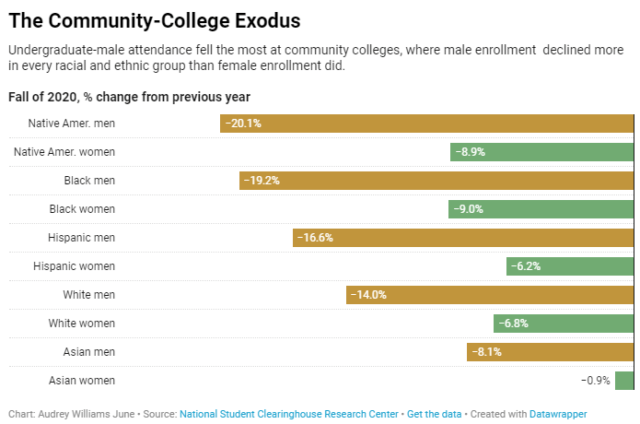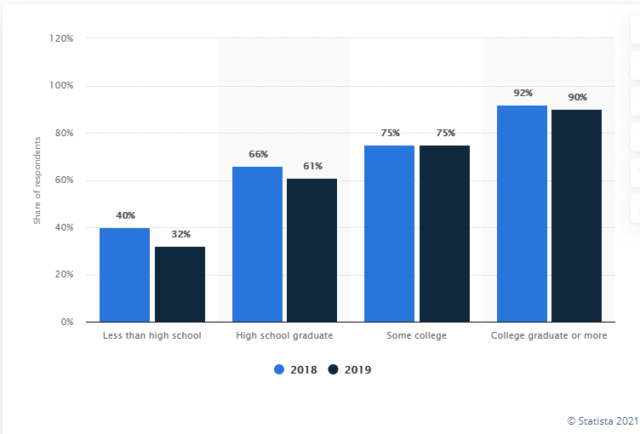Not necessarily connected with the book business, but potentially impacting the economy and the book-buying public. Plus, educational levels and a lack of discretionary income will certainly impact the purchase of books and a great many other optional spending decisions.
From The Chronicle of Higher Education:
George Wilson knew remote learning was not for him. So when his classes went online because of the coronavirus pandemic, Wilson, a then-45-year-old furnace operator in Ohio, did what thousands of men nationwide did last year — he stopped out.
On campus, “I’m a machine,” said Wilson, who is pursuing an associate degree at Lakeland Community College, in Kirtland, Ohio. “I don’t have that same drive at home.”
Wilson is part of an exodus of men away from college that has been taking place for decades, but that accelerated during the pandemic. And it has enormous implications, for colleges and for society at large.
Last fall, male undergraduate enrollment fell by nearly 7 percent, nearly three times as much as female enrollment, according to the National Student Clearinghouse. The decline was the steepest — and the gender gap the largest — among students of color attending community colleges. Black and Hispanic male enrollment at public two-year colleges plummeted by 19.2 and 16.6 percent, respectively, about 10 percentage points more than the drops in Black and Hispanic female enrollment. Drops in enrollment of Asian men were smaller, but still about eight times as great as declines in Asian women.
. . . .

. . . .
In the late 1970s, men and women attended college in almost equal numbers. Today, women account for 57 percent of enrollment and an even greater share of degrees, especially at the level of master’s and above. The explanations for this growing gender imbalance vary from the academic to the social to the economic. Girls, on average, do better in primary and secondary school. Boys are less likely to seek help when they struggle. And they face more pressure to join the work force.
. . . .
In an effort to turn things around, colleges are adding sports teams and majors in fields that tend to attract more men than women, such as criminal justice and information science. They are creating mentoring and advising programs for men, particularly those who are Black and Hispanic. And at least one is hiring a director of Black and males of color‘s success.
But programs and positions catering to men remain relatively rare, said Adrian H. Huerta, an assistant professor of education at the University of Southern California who studies programs for men of color. Those that do exist tend to be untested and underfunded — “a person who is dedicating 25 percent of their time and asked to produce miracles with no money,” he said.
James Shelley, who founded one of the nation’s first men’s resource centers at Lakeland Community College, in 1996 — “the prehistoric period,” he calls it — said many college leaders still view men as a privileged class.
“One thing I often hear is that men still have most of the power, they still make more on the dollar than women, so why create a special program for them?” he said. “It’s not an easy sell.”
. . . .
In 2018, the female-male gap in enrollment among 18- to 24-year-olds stood at eight percentage points for Black and Hispanic students, and six percentage points for white students. Over all, nearly three million fewer men than women enrolled in college that year.
Some of this difference may be due to the belief among some young men that college “isn’t worth it” — that they’re better off going into the work force and avoiding the debt.
“In a lot of communities of color, there’s this mind-set that the man should work, the man should provide,” said Michael Rodriguez, director of the Men’s Resource Center at Kingsborough Community College, in Brooklyn, which is part of the City University of New York. “They think, ‘if I sit around and go to school, I may not be looked at as a functioning provider in my home.’”
. . . .
Though the decision to work after high school may make short-term economic sense, it deprives these men of thousands in lifetime earnings, and deprives colleges of the perspectives they would bring to the classroom — both as students and as future professors, Rodriguez said. “For colleges to really thrive, all voices need to be heard,” he said. “A gender gap creates unhealthy institutions.”
. . . .
But labor-market factors alone can’t fully explain the growing gulf in college completion between men and women. Academic preparation and gender norms play a role, too.
The differences between boys and girls emerge as early as elementary school, where boys lag in literacy skills and are overrepresented in special education. Boys are also more likely than girls to be punished for misbehaving — an experience that can sour them on school.
The disparities in discipline are the most pronounced among Black boys, who made up 15 percent of public-school students in the 2015-16 school year, but accounted for 31 percent of law-enforcement referrals and arrests.
Boys are also less likely than girls to seek or accept help for their academic and emotional struggles, having been socialized to be self-reliant. By the time they’re in middle school, some boys have disengaged from school entirely. Even if they manage to graduate from high school, these boys lack the skill — or the will — to succeed in college.
. . . .
At Lakeland, the decision to create a stand-alone center for men back in the mid-90s stemmed from the success of the college’s women’s resource center, Shelley recalled.
“It was thought that if we have a program that’s such a benefit to women, wouldn’t it make sense to have a similar program for men” who had fallen behind their female peers, he said. The premise was that “men have problems, too.”
But when Shelley began calling around to see what other colleges were doing to support men, he came away empty-handed. “Most of the people I talked to expressed the sentiment that men are the problem,” he said.
Twenty-five years later, Shelley sees this structural “anti-maleness” embedded in school-discipline policies that disproportionately net boys, and in sexual-assault prevention programs that sometimes treat incoming students as threats. “I had one young man tell me ‘I was welcomed to college by being told that I’m a potential rapist,” he said.
. . . .
Shelley, of Lakeland Community College’s resource center, is generally skeptical of efforts to “reprogram” males, believing it better to “channel” their deeply ingrained identities then to attempt to change them. Asking students to share their deepest feelings might work in a women’s group, “but if I ask men that, no will say anything.”
“But if I ask ‘what are your challenges? What do you need to surmount to become successful?’ then it becomes more about problem-solving,” and less about problem-confessing, he said.
. . . .
[H]ands-on fields favored by men were harder to transition to an online environment, said Douglas Shapiro, vice president for research and executive director of the Clearinghouse research center. During the pandemic, enrollment in male-dominated programs like construction, precision production, and firefighting declined two to three times as much as enrollment in nursing and education — fields dominated by women.
“We are losing a generation of men to Covid,” said Huerta. “We need to be really creative about how we get them back in the pipeline.”
That starts with convincing men that college is, indeed, “worth it,” said Rodriguez, particularly when the payoff isn’t immediately obvious.
“When you break down what they want, they really want a job,” he said. “Colleges have to tell a better story of what you can do with an English degree.”
Shelley would like to see colleges create more short-term programs, too, to get men into the work force more quickly. He said that when he tells prospective students a program will take two years, plus prerequisites, they often tell him “forget it.”
Link to the rest at The Chronicle of Higher Education
Share of adults who have read a book in any format in the last 12 months in the United States in 2018 and 2019, by education level

Link to the rest at Statista
“Though the decision to work after high school may make short-term economic sense, it deprives these men of thousands in lifetime earnings,”
Earnings that, depending on the college they go to, may be effectively wiped out by having to pay off the student loan debt they picked up.
“and deprives colleges of the perspectives they would bring to the classroom”
And said perspectives will be rejected the moment they go against the prevailing zeitgeist.
“Though the decision to work after high school may make short-term economic sense, it deprives these men of thousands in lifetime earnings,”
Earnings that, depending on the college they go to, may be effectively wiped out by having to pay off the student loan debt they picked up.
“and deprives colleges of the perspectives they would bring to the classroom”
And said perspectives that will be rejected the moment they go against the prevailing zeitgeist.
At least the “some college” folks are reading the same.
Unless a degree provides some specialized training, I see little difference between a college grad and a smart HS grad in the workplace.
There is a great article in today’s WSJ about people getting masters degrees and earning less than it takes to service the student loan debt. This is a pretty good indication the economy doesn’t value many of the degrees.
High school career guidance these days is a disgrace.
“Follow your passion” doesn’t always pay the bills it creates.